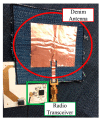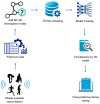Microwave Devices for Wearable Sensors and IoT
- PMID: 37177569
- PMCID: PMC10181738
- DOI: 10.3390/s23094356
Microwave Devices for Wearable Sensors and IoT
Abstract
The Internet of Things (IoT) paradigm is currently highly demanded in multiple scenarios and in particular plays an important role in solving medical-related challenges. RF and microwave technologies, coupled with wireless energy transfer, are interesting candidates because of their inherent contactless spectrometric capabilities and for the wireless transmission of sensing data. This article reviews some recent achievements in the field of wearable sensors, highlighting the benefits that these solutions introduce in operative contexts, such as indoor localization and microwave sensing. Wireless power transfer is an essential requirement to be fulfilled to allow these sensors to be not only wearable but also compact and lightweight while avoiding bulky batteries. Flexible materials and 3D printing polymers, as well as daily garments, are widely exploited within the presented solutions, allowing comfort and wearability without renouncing the robustness and reliability of the built-in wearable sensor.
Keywords: 3D printing; IoT; e-Health; electronics; energy harvesting; fall detection; localization; microfluidics; sensors; wearable; wireless power transfer.
Conflict of interest statement
The authors declare no conflict of interest.
Figures













References
-
- Roggen D., Magnenat S., Waibel M., Tröster G. Wearable Computing. IEEE Robot. Autom. Mag. 2011;18:83–95. doi: 10.1109/MRA.2011.940992. - DOI
-
- Castillejo P., Martinez J.-F., Rodriguez-Molina J., Cuerva A. Integration of wearable devices in a wireless sensor network for an E-health application. IEEE Wirel. Commun. 2013;20:38–49. doi: 10.1109/MWC.2013.6590049. - DOI
Publication types
Grants and funding
LinkOut - more resources
Full Text Sources

